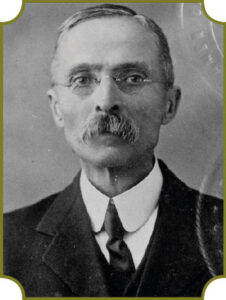
Stephen Nelson Haskell was one of the most travelled early Adventist leaders, who led the first missionary group who came to Australia in 1885. He won the first Adventist convert in New Zealand, Edward Hare, and helped establish the Avondale School for Christian Workers (aka Avondale University) where he taught Bible.

Arthur Grosvenor Daniells was one of Adventism’s most dynamic ministers and administrators. His career began in New Zealand, where he established the Church by conducting evangelistic meetings, later being elected as president of the newly formed New Zealand Conference. Moving to Australia, he persevered in conducting tent meetings despite initial resistance, became the conference president, and played a crucial role in the growth of the Adventist Church through literature distribution and public-meeting evangelism, as well as being involved in the founding of the Avondale School.

Mendel Crocker Israel was part of the group who brought the Adventist message to Australia and New Zealand in 1885. Israel conducted successful evangelistic campaigns, published the magazine Bible Echo and Signs of the Times, and played a key role in organising the Adventist Church in Australia. He later served as the president of the New Zealand Conference and made notable contributions to the growth of the Church in New Zealand.

One of Seventh-day Adventism’s most vigorous exponents was John Orr Corliss, who came to Australia in the first missionary team. Corliss gave early attention to establishing what became known as the Echo Publishing House and effectively became its managing editor. When he departed after two years, he left behind over 200 converts won to the Adventist cause in Melbourne, Ballarat, Adelaide and elsewhere.

George Burt Starr, a one-time associate of evangelist Dwight L Moody, arrived in Sydney in 1891 accompanied by Ellen White. The Starrs were to give 18 years to building up the Church in Australia and New Zealand. Pastor George B Starr was involved in the establishment of Avondale School, teaching Bible while his wife acted as matron for the boarding students.

“The best monument a missionary can leave behind him is a well-trained native ministry and a literature in the vernacular.” So spoke John Edwin Fulton, who achieved both for Fiji in the nearly 10 years he served there. Learning to speak the local language with an almost true accent, he was a man greatly beloved by the Fijian people. John Fulton gave 25 years to Australasia as a missionary and administrator. His name is forever linked with Fulton College, Fiji.

Edward Harmon Gates was chosen to lead a group of missionaries to the South Pacific in 1890, where he organised churches and baptised numerous islanders. Gates played a pivotal role in establishing missions, training schools and printing presses in the Pacific region, and he served as the superintendent of Mission Fields for a decade.

John Henry Woods contributed to the early Adventist movement by printing the Bible Echo and Signs of the Times in his print shop. He later became involved in church activities, being one of the first ordained Australians, and was elected as the first president of the South Australian Conference. He continued to serve in various leadership positions until his death.

Albert William Anderson was a pastor, editor, writer and administrator in the Australasian Division. Anderson’s most significant contributions include his leadership in the publishing work (as a former editor of Record), his role in establishing the Sanitarium Health Food Company and his advocacy for religious liberty. He played a crucial part in the campaign to amend the federal constitution of Australia to secure religious freedom and Sabbath rights for young men in military training, making him a respected counsellor and leader in the movement.

Robert Hare was one of the first and most successful public evangelists in Australia and New Zealand, combining his gift for evangelism with oratory and writing. Hare’s work helped establish Adventist churches, particularly in Gisborne, Palmerston North and Western Australia. His passion for literature led him to compose more than 2000 poems, earning him recognition from the International Mark Twain Society. His influence extended to the camp meeting circuit and various Pacific Islands, leaving a lasting impact on the Adventist movement in the region.






